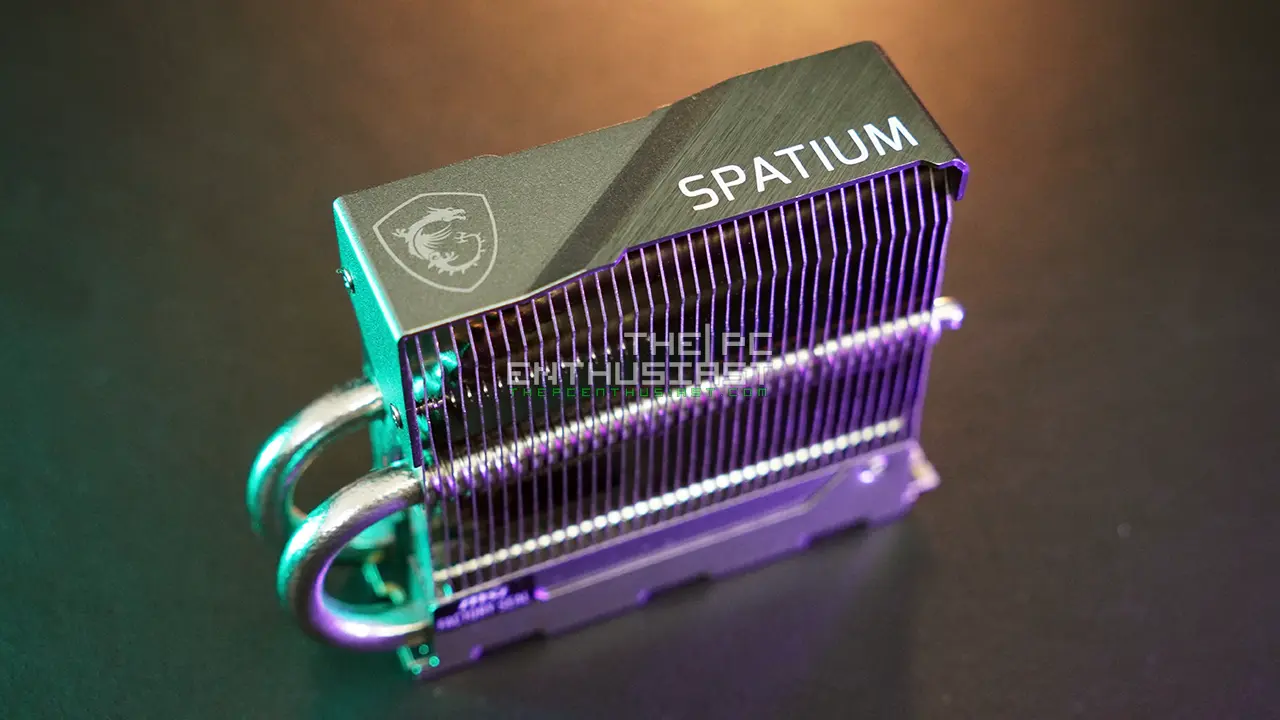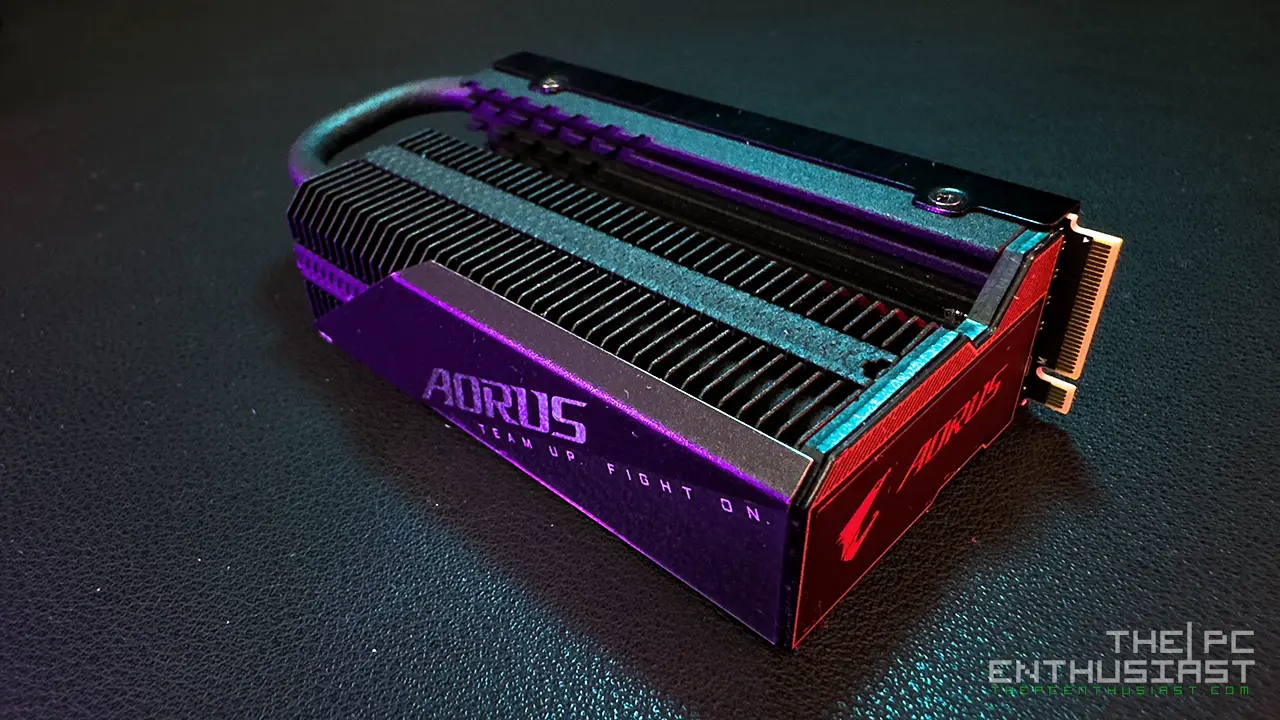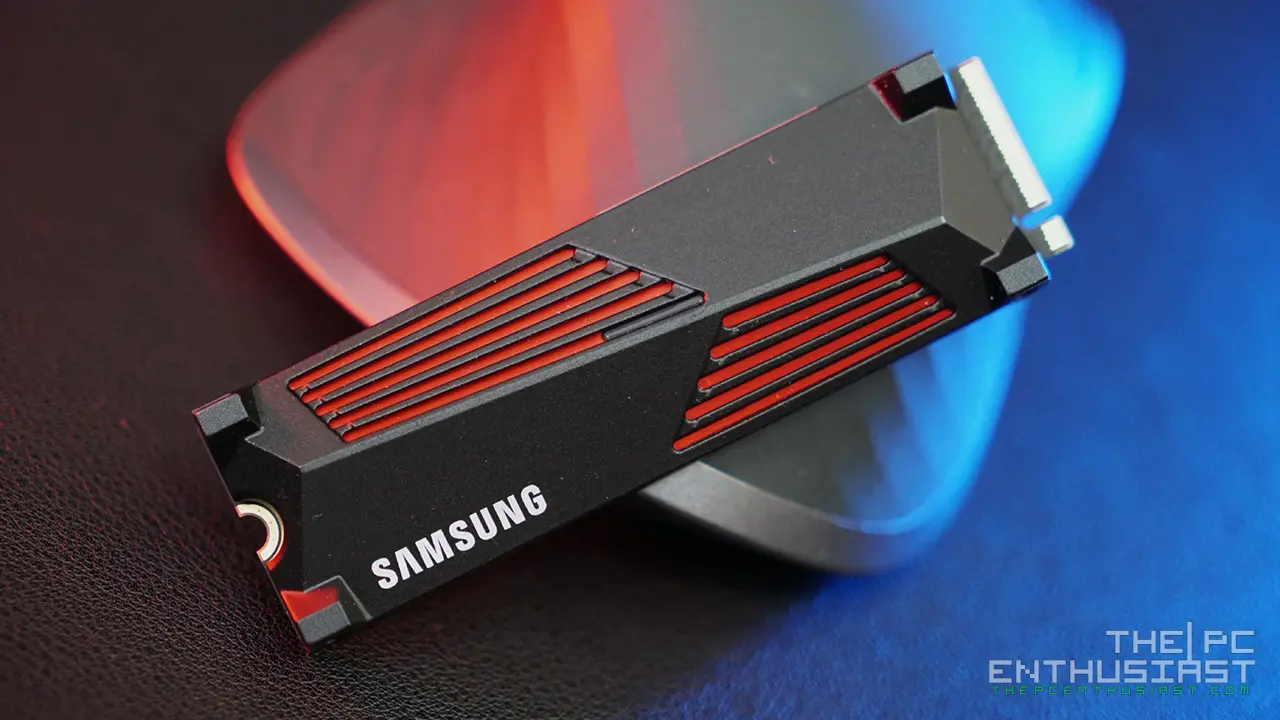Second-quarter of this year, Viper Gaming by Patriot, released its latest Gen4 NVMe SSD – the Patriot Viper VP4300 PCIe m.2 Gen4 SSD. It promises sequential read speeds of up to 7,400MB/s and sequential write speeds of up to 6,800MB/s. The new VP4300 is powered by an Innogrit IG5236 Gen4x4 controller. It aims to compete with other Gen4 SSDs that are powered by Phison’s E18 controller. And unlike most SSDs in the market, the Viper VP4300 comes with two optional heatshields; aluminum and a Graphene heat spreader. Let’s find out how the Viper VP4300 SSD performs and if it can keep up with the competition. Please continue reading our Patriot Viper VP4300 M.2 Gen4 SSD review below.
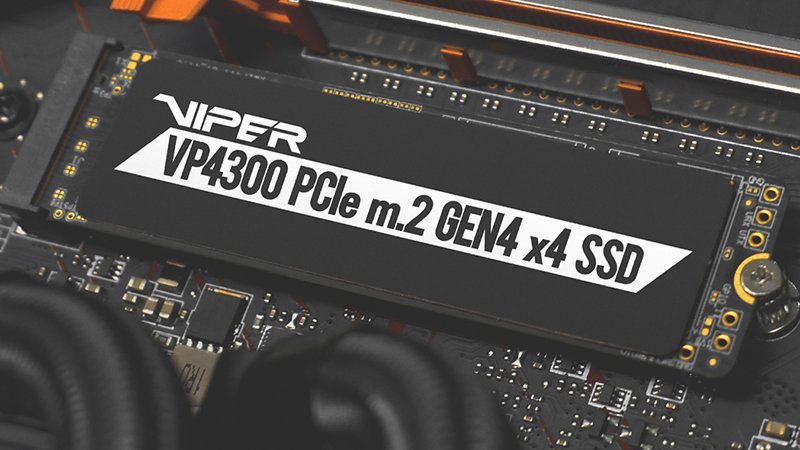
- Patriot Viper VP4300 PCIe m.2 Gen4 SSD Review – 1TB Capacity
- Patriot Viper VP4300 Specifications
- Packaging and Closer Look
- The Test Setup
- Patriot Viper VP4300 Gen4 SSD (1TB) Benchmark Results
- Patriot Viper VP4300 Gen4 SSD (1TB) Temperature
- Pricing and Availability
- Patriot Viper VP4300 Gen4 NVMe SSD Review Conclusion
Patriot Viper VP4300 PCIe m.2 Gen4 SSD Review – 1TB Capacity
PATRIOT VIPER released its Viper VP4300 PCIe Gen4x4 NVME M.2 2280 SSD last April. It features the latest Innogrit Gen 4×4 high-speed controller-IG5236, paired with a high-quality DDR4 DRAM cache from SK Hynix. The company is using a 10-layer PCB to “guarantee excellent signal integrity and stability”.
The Viper VP4300 offers 4K random read and random write of up to 8000K IOPs. In addition, it also offers sequential read and write speeds of up to 7,400MB/s and 6,800MB/s, respectively. Can it reach those advertised speeds? Let’s find in this review.
One of the unique features that the VP4300 offers is the option to choose from two different heat spreaders. It comes with an aluminum heatshield and a thin, single-use, graphene thermal pad. Interestingly, Patriot says both heat spreaders can be used together or independently in a variety of different system configurations.
The VP4300 is available only in two capacities; 1TB and 2TB. Below are the specifications of each capacity.
Patriot Viper VP4300 Specifications
| 1TB | 2TB | |
|---|---|---|
| Part Number | VP4300-1TBM28H | VP4300-2TBM28H |
| Form Factor | M.2 2280 | M.2 2280 |
| Interface / Protocol | PCIe 4.0 x4 / NVMe 1.4 | PCIe 4.0 x4 / NVMe 1.4 |
| Controller | InnoGrit IG5236 | InnoGrit IG5236 |
| DRAM | DDR4 | DDR4 |
| Memory | Micron 96 Layer TLC | Micron 96 Layer TLC |
| Sequential Read | up to 7,400 MBps | up to 7,400 MBps |
| Sequential Write | up to 6,800 MBps | up to 6,800 MBps |
| Random Read | up to800,000 IOPS | up to 800,000 IOPS |
| Random Write | up to 800,000 IOPS | up to 800,000 IOPS |
| Security | AES 256-bit encryption | AES 256-bit encryption |
| Endurance (TBW) | 1,000 TB | 2,000 TB |
| Warranty | 5 Years | 5 Years |
Packaging and Closer Look
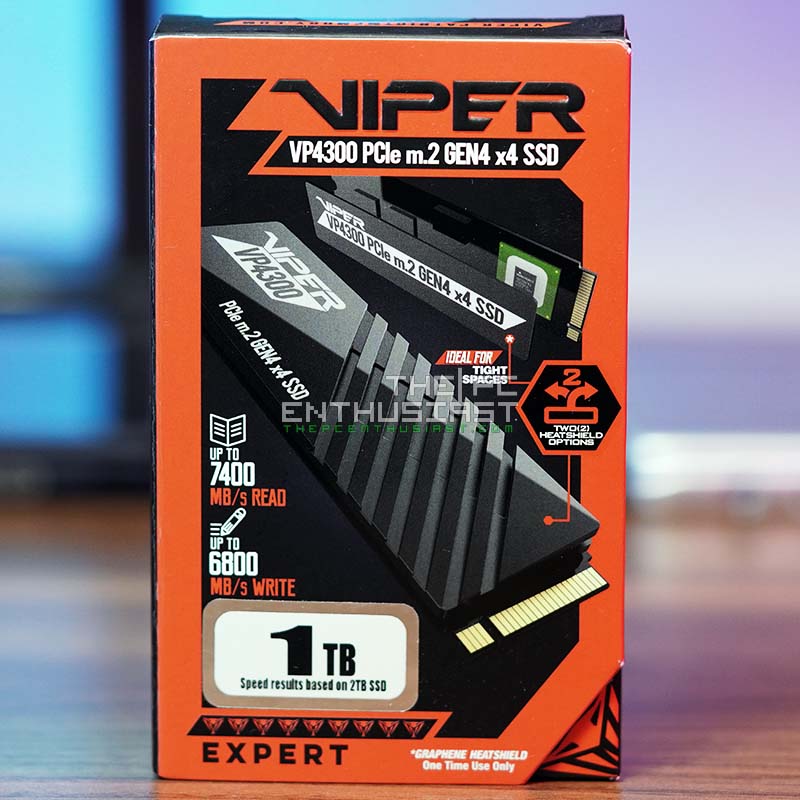
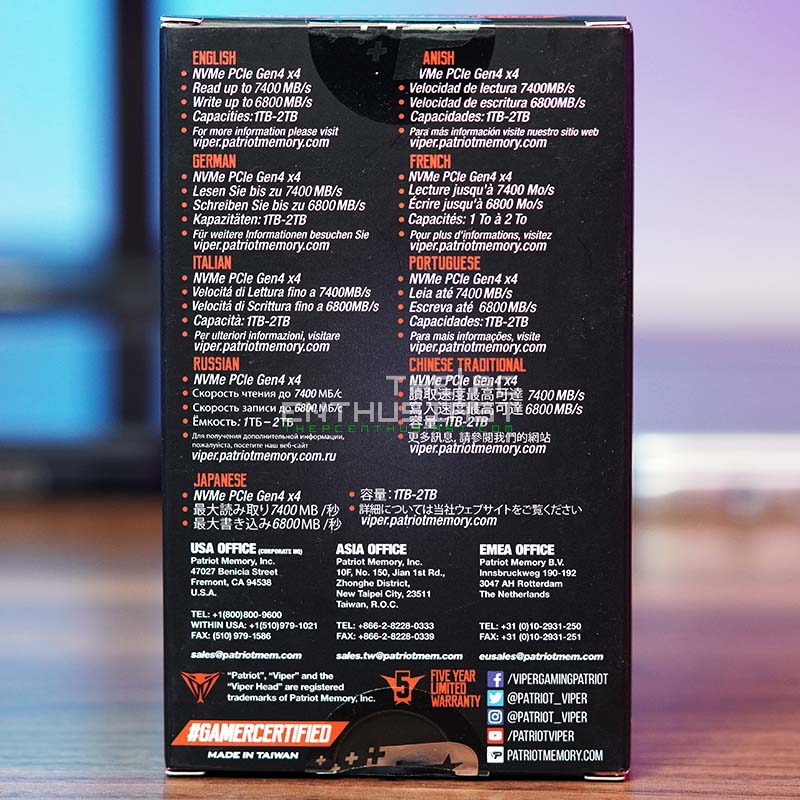
The Viper VP4300 came in with a red and black color theme retail box. It’s a classic “gaming” color scheme before RGB took over. At the front portion of the box, you can see the advertised speeds and the capacity of the drive. It also highlights that there are two types of heat spreaders included. At the back of the box are some of the drive’s features in multi-language format.
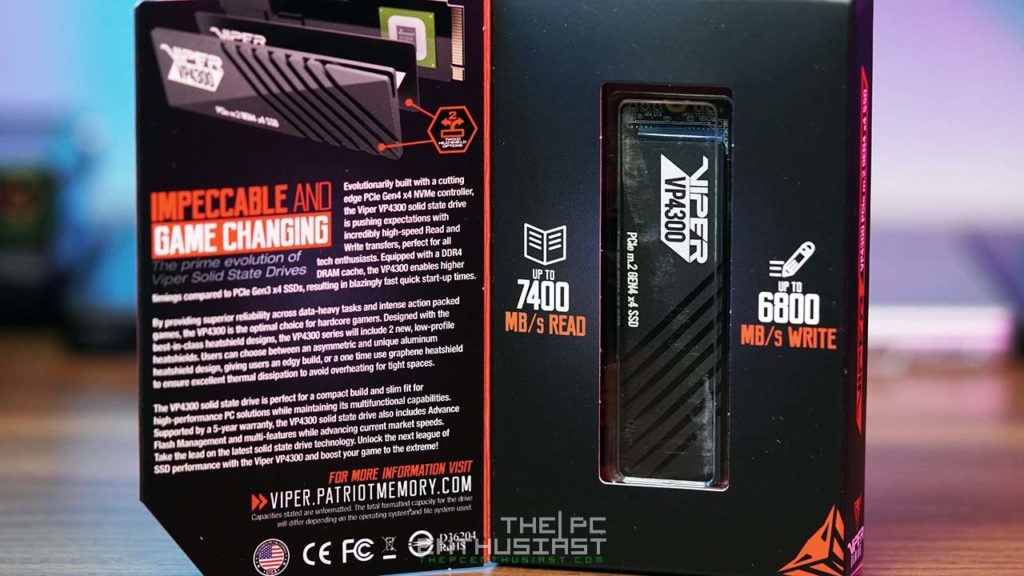

The packaging has a flip cover, and there’s a window where you can see the product. Included in the box are the VP4300; a quick start guide; the graphene heat spreader and the thicker aluminum heat spreader. Now, the graphene heat spreader doesn’t feel and looks like it’s made of graphene. It looks like a think-copper sheet instead. Similar to what we saw on the Sabrent Rocket 4 Plus.
The PCB and Main Components

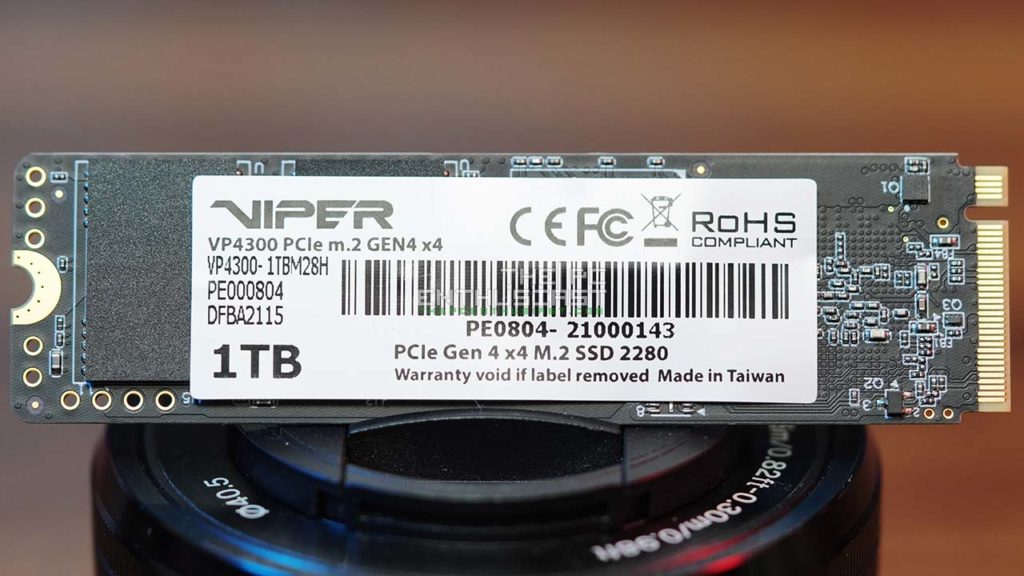
Patriot Viper claims that they are using a 10-layer PCB for its VP4300 Gen4 SSD. Above you can see the front and rear view of the SSD. Good thing that they put the sticker label at the back-side of the SSD since we don’t want it interfering with the heat transfer.
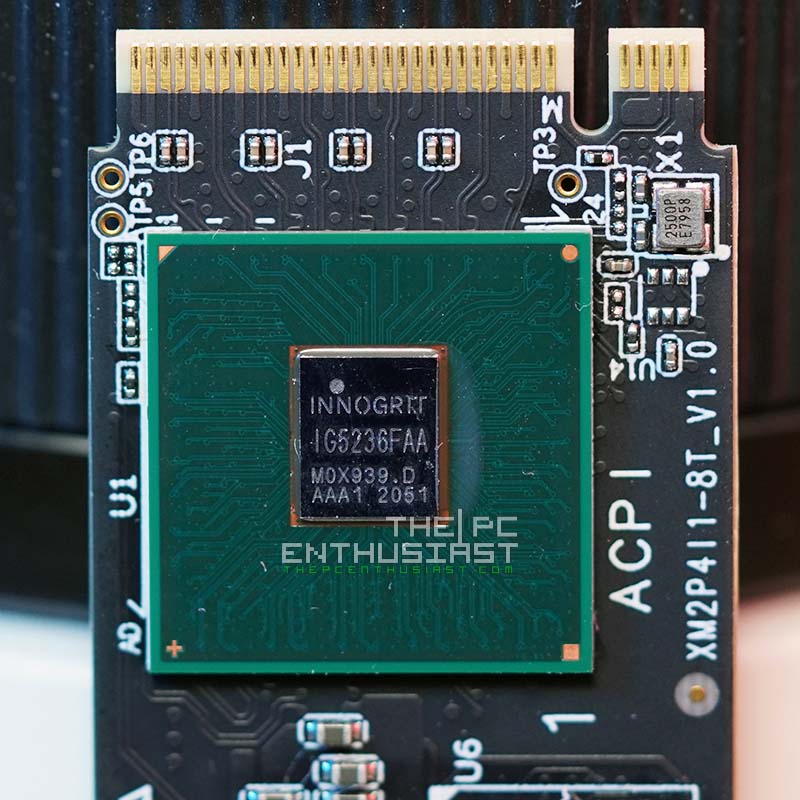

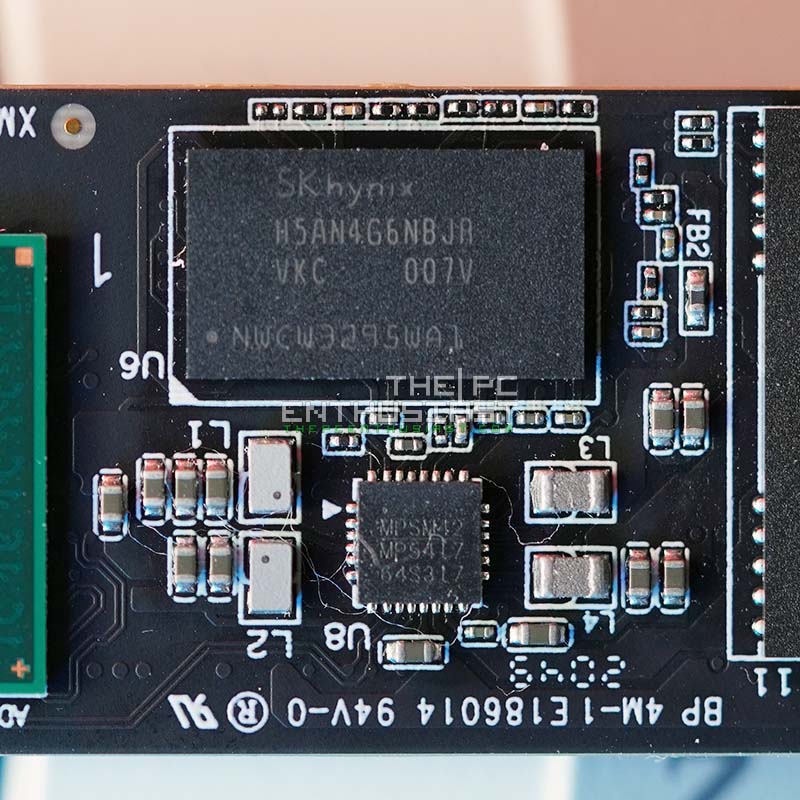
The InnoGrit IG5236 is the latest controller from the company. It looks different from Phison’s E18 controller. Interestingly, it looks like a small CPU without its integrated heat spreader (IHS). Viper is also using Micron’s 96-layer TLC NAND flash, labeled PFMC-B6F36A1CC0. However, it looks like the chip is rebranded since we don’t see Micron’s logo etched on the chip. Finally, there’s the SKhynix H5AN4G6NBJR-VKC DDR DRAM.
The Test Setup
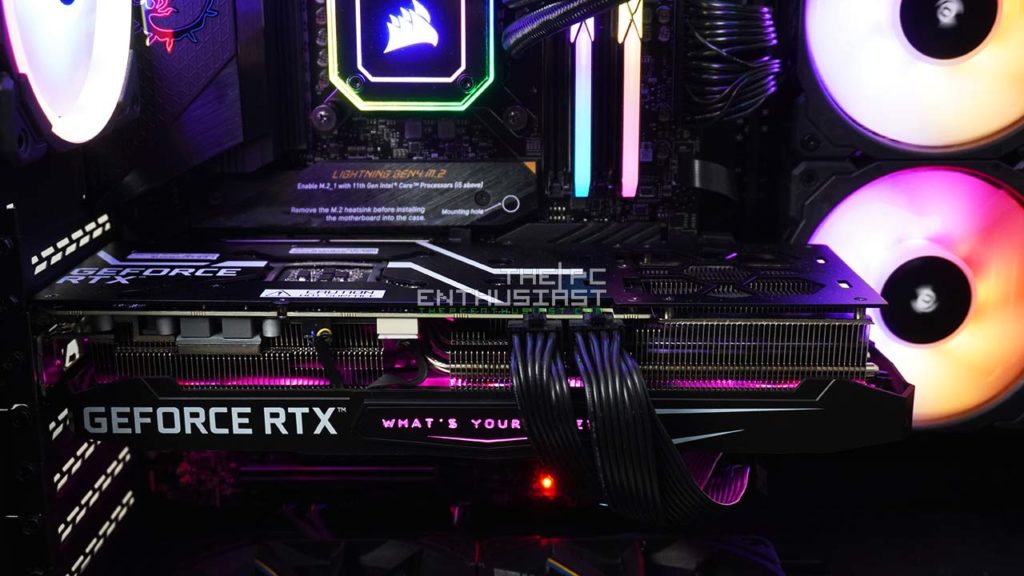
I usually test these (Gen4) SSDs on my MSI MEG X570 ACE motherboard with Ryzen 3700X. But this time, I’ll be using a different test system. This is an MSI MEG Z590 ACE motherboard, powered with an 11th Gen Intel Core i5-11400F processor. Below are the rest of the specifications of the system:
| Operating System | Windows 10 Pro 64bit |
| Processor | Intel Core i5-11400F (running stock) |
| Motherboard | MSI MEG Z590 ACE |
| Memory | Thermaltake Toughram XG RGB DDR4-4000 16GB |
| Graphics Card | GALAX GeForce RTX 3070 Ti SG |
| OS Drive | Crucial P5 NVMe SSD 2TB |
| Power Supply | SilverStone SX1000 Platinum SFX-L 1000W PSU |
| Chassis | Lian Li O11 Dynamic Mini |
Patriot Viper VP4300 Gen4 SSD (1TB) Benchmark Results
Before we proceed, I’d like to clarify that only the Patriot Viper VP4300 and Sabrent Rocket 4 Plus were tested on the same Intel Z590 system. The rest of the SSDs from the results below were tested on the AMD X570 test system.
Finally, I tested the VP4300 using its included (thick) heat sink. I noticed that with the thinner heat spreader, the VP4300 tends to run hot and it is throttling the drive, especially during a prolonged test. I’ll show you the temperature after the benchmark results.
AJA Benchmark Results

In the AJA System Test, the VP4300 was performing slightly slower compared to the Phison E18-powered Rocket 4 Plus and Aorus 7000s. It only got around 4600MB/s sequential read speed and 5000MB/s sequential write speed. But it is still faster than its predecessors, 1st gen Gen4 SSDs, like the VP4100.
AS SSD Benchmark Results

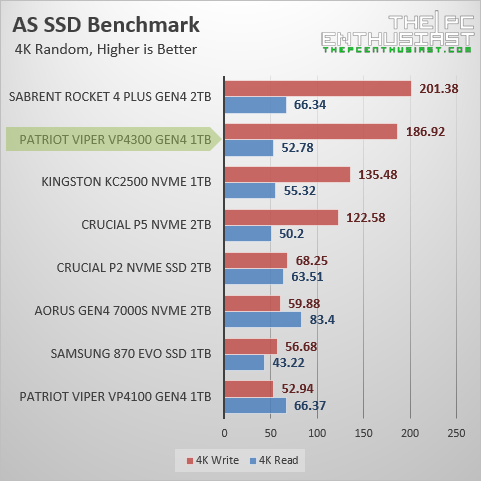
We can see that the Viper VP4300 1TB performed well on the AS SSD benchmark test, both in sequential and random tests. The VP4300 is slightly faster than the Aorus 7000s in the sequential read test but slightly falls behind in the sequential write test. The difference is very minimal and may be negligible. Meanwhile, the VP4300 performed well on the 4k random test, just trailing behind the Sabrent Rocket 4 Plus.
ATTO Disk Benchmark Results
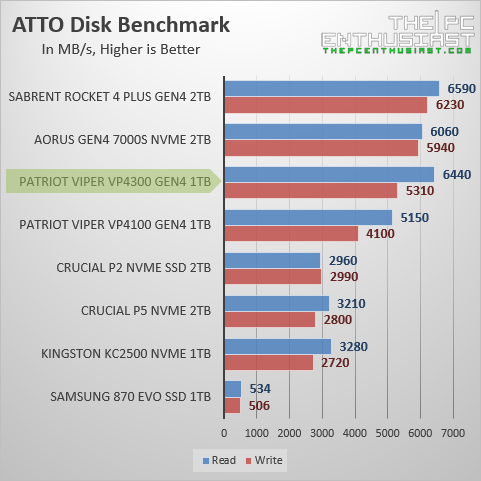
I was expecting to see the Viper VP4300 hitting its advertised speed on the ATTO disk benchmark. However, I only got around 6,400MB/s sequential read and 5,300MB/s sequential write. That’s around 1,000MB/s slower than its advertised speed. Nevertheless, it is catching up with the E18-controlled NVMe SSDs.
CrystalDiskMark Benchmark Results
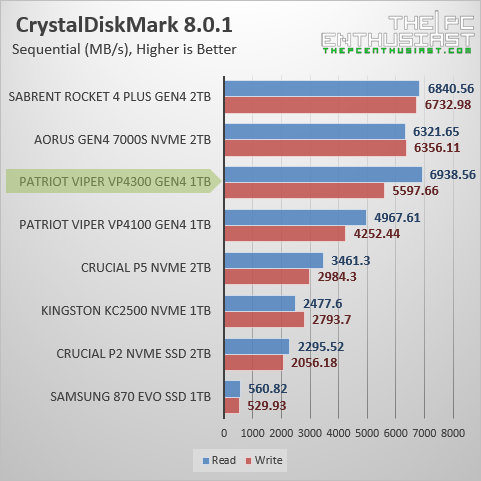
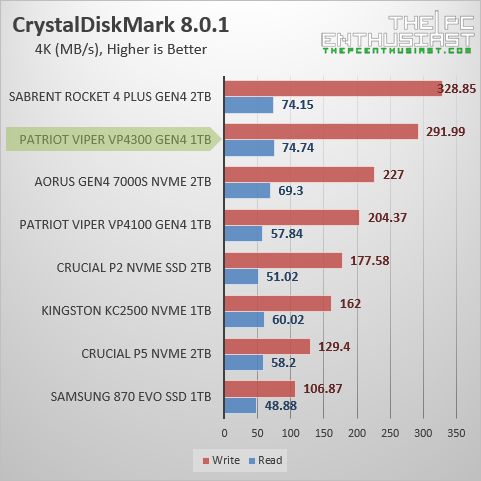
In the CrystalDiskMark benchmark, the VP4300 is in a similar situation, where it falls behind the two other Gen4 SSDs. However, it almost reached 7,000MB/s sequential read and it has been consistently performing well during random tests.
ezIOmeter Benchmark Results

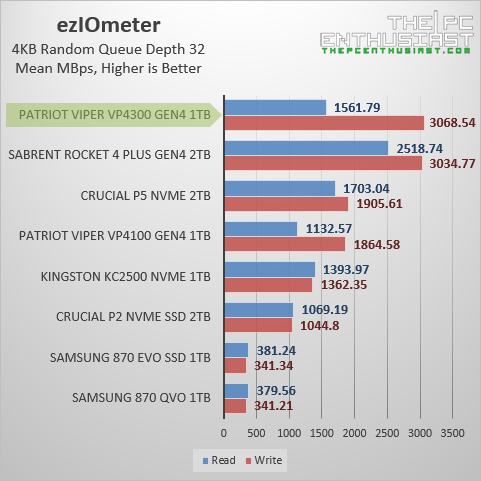
Again, the VP4300 is trailing slightly behind the Sabrent Rocket 4 Plus. The sequential test is consistent and is somewhat similar to the CrystalDiskMark result. And during the 4KB random test, it performed a hairline faster than the Rocket 4 Plus in random write, while falling behind in random read.
PCMark 10 Full System Drive Results
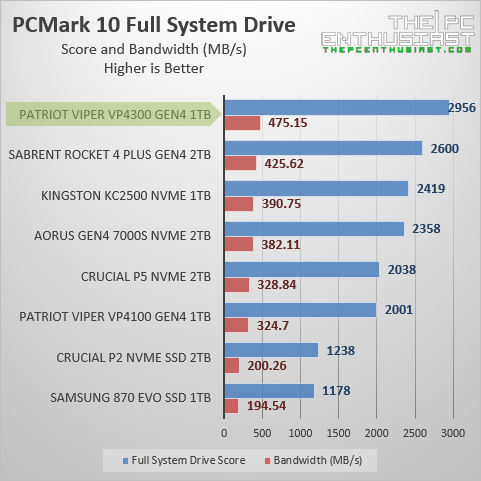
Last but not the least, I tested the Patriot Viper VP4300 1TB SSD using the PCMark 10 Full System drive benchmark suite. It is an intensive test and takes about an hour (or more) to finish. The test uses a wide-ranging set of real-world traces from popular applications (Adobe Creative Suite, Microsoft Office), and common tasks to fully test the performance of modern drives.
To my surprise, the VP4300 performed well overall and it is on top of the chart. Although it was trailing behind in the previous benchmark tests, which didn’t last long, the VP4300 performed well in the long run or in general.
I did run the test two more times for consistency, and it ended up with the same result as before. I guess, the VP4300 performed well overall since it was able to offer a good balance between sequential and random workloads. While it did not end up as the fastest on a single benchmark test, it performed well on a series of tests.
Patriot Viper VP4300 Gen4 SSD (1TB) Temperature
Many traditional NVMe SSDs set performance restrictions that limit Read and Write data transfer speeds to maintain a workable operating temperature. According to Patriot Viper, the VP4300 is designed with a “cutting-edge Thermal Throttling technology” that uses a built-in thermal sensor and firmware to manage the SSD temperature. This will prevent overheating and easily leverage the best performance under a variety of different system tasks.
Below are two screenshots that I got while testing the VP4300. The first one is using the thin heat spreader, while the next one is with the aluminum heat sink.

Using the graphene heat spreader, the VP4300 1TB capacity peaked at 72°C with an average of 62°C. I noticed that without decent cooling, its performance is slightly affected, especially during prolonged use.

However, with the thicker aluminum heat sink, its highest temperature only peaked at 64°C, with an average of 55°C. That’s a significant drop in temperature. And as a result, the VP4300 1TB SSD performed consistently without throttling during the test.
So, as much as possible, it is advisable to use the thicker heat sink or if your motherboard already has a (thick) heat sink for the M.2 drives, better make use of it. The only scenario where you should use the thinner graphene heat spreader is when space is limited or constricted.
Pricing and Availability
The Patriot Viper VP4300 PCIe M.2 Gen4 SSD series is now available. It comes with a manufacturer’s suggested retail price of $254.99 for the 1TB capacity and $499.99 for the 2TB capacity. Patriot Viper is also offering a 5-year limited warranty for the said drive. Since this drive has been in the market for a while now, the retail prices have adjusted already.
Patriot Viper VP4300 Gen4 NVMe SSD Review Conclusion
Innogrit’s latest IG5236 Gen4 SSD controller proved to be a worthy competitor to Phison’s E18 controller. As you have seen from the benchmark results above, the Viper VP4300 was able to perform well overall. While it didn’t end up the fastest on a specific benchmark test, it was on top of the chart during prolonged benchmark tests using the PCMark 10 full-system drive test. I was not expecting that to be honest.
Patriot Viper also gave users the option to choose between a thinner graphene heat spreader or a thicker aluminum heatsink. I recommend using the thicker aluminum heatsink whenever possible. And only use the thinner heat spreader if the space is limited or constrained.
While I don’t put too much weight on software or SSD utility, the VP4300 doesn’t come with any software or application tool. Although, there is software from third parties that you can use if ever you need to diagnose the SSD. It’s not a huge deal for me, but it may be something to consider for some.
The Competition
While the overall performance of the Viper VP4300 is good, it is not the only SSD in the market. The SSD market is very competitive and quite congested. The VP4300 is facing fierce competition from the likes of Samsung 980 Pro, Sabrent Rocket 4 Plus, Aorus Gen4 7000s, WD Black SN850, and Corsair MP600 Pro. These Gen4 SSDs are just some of the many, there are a lot more out there.
Finally…
The Patriot Viper VP4300 M.2 Gen4 SSD is no slouch. It’s not the fastest drive we have tested, but it is certainly faster than the early 1st gen Gen4 NVMe SSDs and it can compete with the lastest Gen4 SSDs in the market. However, this will all come down to pricing. The product is solid and great overall, but I think Patriot Viper needs to adjust the price to make it more attractive and competitive. If ever you spot the VP4300 for a lower price or a good deal, I don’t have any problem recommending it at all.



